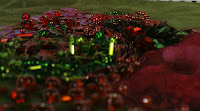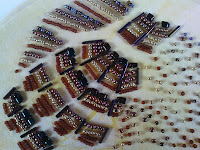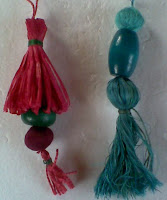From buttons to beads, these two samples started life as buttons but thought they sat better in the beads chapter. Ref 3.8.1

Wanting to get a feeling of movement, but not be too formal, shapes were sketched onto fabric and built the texture to the designs as I went along. In hindsight think a bit more consideration of the design detail may have achieved better areas of work. I seemed to move onto different ideas before a larger enough area of one idea had been worked. In the yellow/purple sample, Ref 3.8.3 think I went too far in the other direction!!
The other shape selected was the shell.
Ref 3.8.3 a Ref 3.8.3 b
The shell stamp above, has gaps between the stamp giving a feeling of ridges over the surface. Perhaps a line of hand stitching would define this more in the beaded piece.
To get back on track with the specific tasks asked for in this chapter the sample Ref 3.8.4 includes a range of unconventional 'beads' and a few more methods of stitching down onto a hand dyed muslin and felt base with chiffon on the right hand side of the panel.
Going from top left hand section:
Shell fragment and short ribbons of 'pearl' beads; cogs and copper nails attached with buttonhole stitch; dyed squash seeds in a nest of threads, attached with fly stitch, covered in chiffon; assorted metal nuts covered in chiffon and secured in straight stitch and cross stitch grid and a series of bullion knots;
bottom row left hand section:
computer floppy disk centres covered with threads or felt attached with whipped spider stitch; shells attached with button hole stitch(bottom left) or cross stitch; loop of dyed squash seeds attached with daisy stitch and waste core metal couched onto fabric; electronic circuit components attached with long and short stitch, over and under a chiffon layer. To show more detail, see below.
detail of Ref 3.8.4 a detail of Ref 3.8.4.b










































